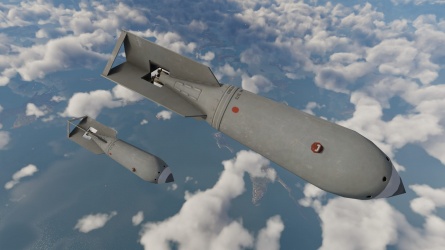Navy Type 3 Number 150 AP (1,500 kg)
| This page is about the Japanese bomb Navy Type 3 Number 150 AP (1,500 kg). For other uses, see Type 3 (Disambiguation). |
Contents
Description
Write an introduction to the article in 2-3 small paragraphs. Briefly tell us about the history of the development and combat using the weaponry and also about its features. Compile a list of air, ground, or naval vehicles that feature this weapon system in the game.
Vehicles equipped with this weapon
General info
| Bomb characteristics | |
|---|---|
| Mass | 1,498.6 kg |
| Explosive mass | 89.81 kg |
| Explosive type | Type 91 |
| TNT equivalent | 94.3 kg |
| HE max penetration | 78 mm |
| Armour destruction radius | 6 m |
| Fragment dispersion radius | 100 m |
Effective damage
Damage output from near-misses is very comparable to the Type 98 Number 25, but if the bomb manages to penetrate inside the vessel, it typically does a guaranteed kill, or a crippling damage to even the largest battleships.
Comparison with analogues
There are very, very few heavy armour-piercing bombs available, making it difficult to make a fair comparison, as most nations lack any bombs that could be thought of as an analogue. Still, among those few peers that exist, the Type 3 Number 150 has rather small explosive filler and a low penetration, being grossly outmatched by the German counterpart.
| Bomb | Mass (kg) |
TNT equivalent (kg) |
Penetration @ 30° @ 100 m (mm) |
Penetration @ 0° @ 2000 m (mm) | |
|---|---|---|---|---|---|
| |
PC1600 (1,600 kg) | 1600 | 294.91 | 96 | 120 |
| |
A.P. Mk.I (2,000 lb) | 877.2 | 70.78 | 75 | 126 |
| |
Navy Type 3 Number 150 AP (1,500 kg) | 1498.6 | 94.3 | 78 | 121 |
Usage in battles
Describe situations when you would utilise this bomb in-game (vehicle, pillbox, base, etc)
Pros and cons
Summarise and briefly evaluate the weaponry in terms of its characteristics and combat effectiveness. Mark pros and cons as a list.
Pros:
Cons:
History
Examine the history of the creation and combat usage of the weapon in more detail than in the introduction. If the historical reference turns out to be too long, take it to a separate article, taking a link to the article about the weapon and adding a block "/History" (example: https://wiki.warthunder.com/(Weapon-name)/History) and add a link to it here using the main template. Be sure to reference text and sources by using <ref></ref>, as well as adding them at the end of the article with <references />.
Media
Excellent additions to the article would be video guides, screenshots from the game, and photos.
See also
External links
Paste links to sources and external resources, such as:
- topic on the official game forum;
- other literature.
| Armour-piercing bombs | |
|---|---|
| USA | |
| 1,000 lb | A.P. AN-MK 33 |
| 1,600 lb | AN-Mk 1 |
| Germany | |
| 10 kg | SD10C |
| 50 kg | SD50 |
| 70 kg | SD70 |
| 500 kg | PC500 |
| 1,000 kg | PC1000 |
| 1,400 kg | PC 1400 X* |
| 1,600 kg | PC1600 |
| USSR | |
| 220 kg | BRAB-220 (1930) |
| 250 kg | BRAB-250 |
| 500 kg | BRAB-500 (1938) · BRAB-500 |
| 1,000 kg | BRAB-1000 |
| Britain | |
| 500 lb | S.A.P. Mk.II |
| 2,000 lb | A.P. Mk.I |
| Japan | |
| 500 kg | Number Type 2 50 Model 1 GP(SAP) |
| 800 kg | Navy Type 99 Number 80 AP |
| 1,500 kg | Navy Type 3 Number 150 AP |
| Italy | |
| 160 kg | A.P 160 |
| 630 kg | 630 P.D. |
| * Guided bomb | |
| See also | List of high-explosive, unguided, free-falling bombs · List of guided bombs · List of retarded bombs |




